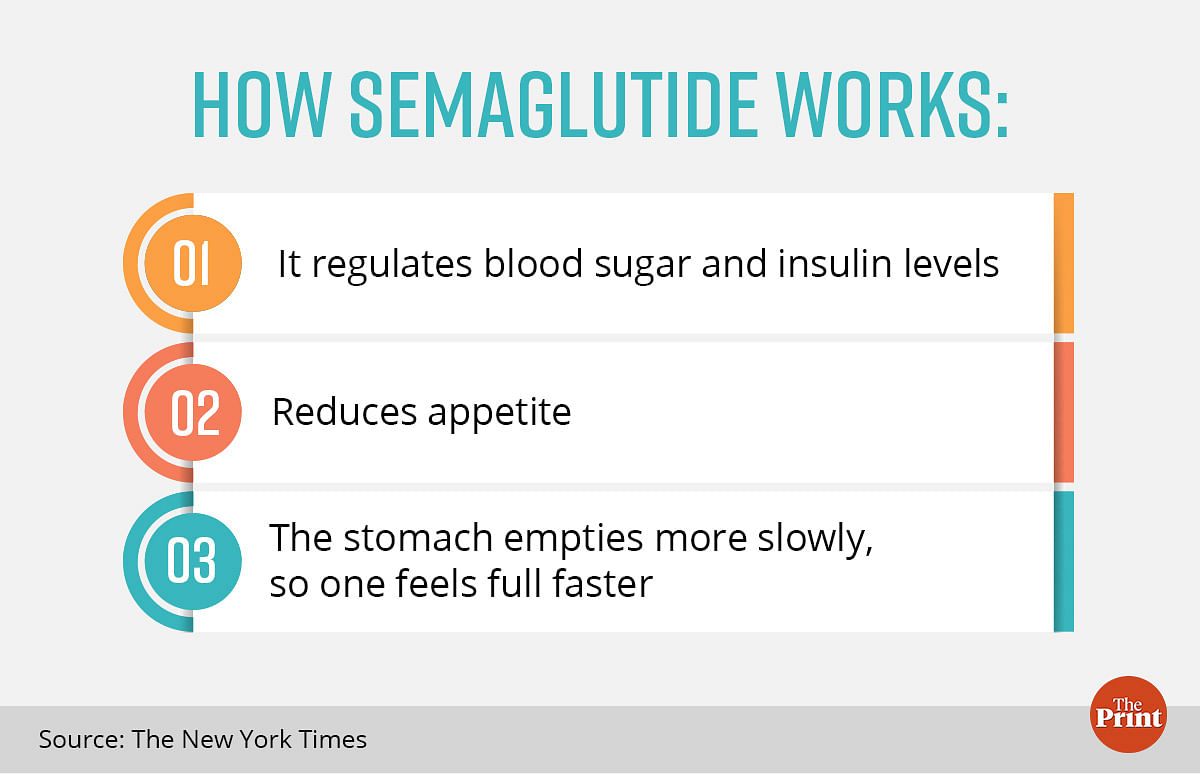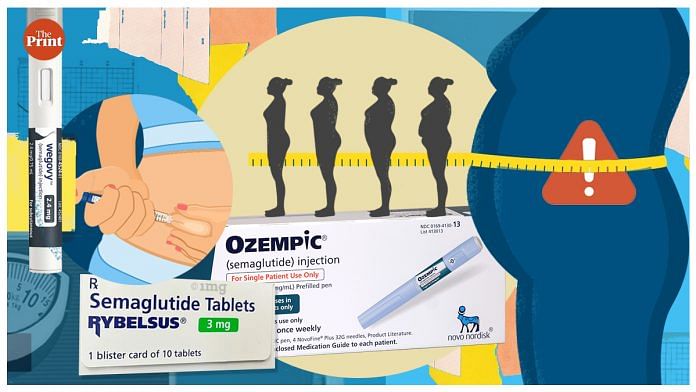New Delhi: One of Dr. Sharanjit Kour Sodhi’s patients hasn’t told anyone the secret behind her dramatic weight loss. Four months ago, she was 104 kg, and now she’s a cool 90. She is ecstatic — clothes that were once tight are now loose, and her sugar cravings have vanished. She is no longer on a diet or panting on a treadmill. She has other things like a massive house renovation on her mind. But still, the inches continue to drop. And it’s all courtesy semaglutide, a weight loss drug. And it’s all because of semaglutide or the Ozempic revolution as it’s more popularly called on social media.
“I knew I wanted to get thin. All my suits were tight,” she said.
She and her daughter are both taking an oral form of semaglutide under the brand name Rybelsus. Both of them are pre-diabetic. Diabetes and obesity are often treated simultaneously, even spawning their own portmanteau: diabesity. Almost 80-90 per cent of pre-diabetic patients have been found to be obese. In its social media savvy avatar, semaglutide has taken over as Ozempic and Wegovy — weight loss injections that have been fashioned as a ‘miracle drug’ for those drained by ineffective diets and workout regimes. In India, the flood gates are yet to open, but already doctors, especially those in private luxury weight loss clinics, are getting inquiries.
Rybelsus Semaglutide was approved last year in India to treat Type-2 diabetes. The injectables are yet to enter the local market, but are covertly procured by a small section of society.
Given the hype, semaglutide is gaining traction across India with the requests pouring in – more so in private, luxury clinics –– their clients are also able to get their hands on Ozempic and Wegovy, injections that are yet to be approved in India. It is still not a game changer of mythic proportions, but it represents hope for those battling obesity and body image issues.
“There’s finally a weight loss drug that works. It’s a huge shift from traditional medication,” said Dr. Kiran Sethi, an aesthetic and wellness doctor. But there are strings. In order to retain that ideal body, the drug needs to be taken forever. That hasn’t stopped the clamour for the drug among clients looking to shed excess kilos.
“This is an obvious side effect. Quality of life is not very good,” said Dr. Sudhir Kalhan, chairman of the Institute of Minimal Access, Metabolic and Bariatric Surgery at Ganga Ram Hospital in Delhi. “But we’re fighting a war [against obesity], and you need all the armour you can get.”

Also read: After K-culture boom, Indian women loving Thai queer drama. ‘We can see 2 handsome men’
Demand, availability and the cost
Semaglutide may be the answer, but the price is a clear caveat. An Ozempic injection costs at least Rs 20,000 per shot if procured from a pharmacy that sells imported brands. Its weekly dosage means that a customer can end up paying more than Rs 80,000 a month. It’s available off-label but only through prescription. A well-known chain told ThePrint that while it is not presently available, “it can be arranged.”
Despite the fact they haven’t been approved by, Ozempic injections are sold in all their glory on e-retailer IndiaMart.
There are a slew of suppliers as well. The drug available appears to be
legitimate, with drugmaker Novo Nordisk listed as the manufacturer.
There’s finally a weight loss drug that works. It’s a huge shift from
traditional medication
said Dr. Kiran Sethi, an aesthetic and wellness doctor.
The shots cannot be purchased directly from the website, which acts as an intermediary between the supplier and the customer. Here, the price points are steep, going up to Rs 55,000. An Ozempic injection needs to be taken once a week, possibly permanently.
Rybelsus, which is available in India, needs to be taken daily. Each tablet is Rs 300, which means that users rack up costs of at least Rs 10,000 per month.
It’s an expensive weapon in the war against obesity. According to a Lancet study that assesses the fifth round of National Health and Family Survey data (NFHS-5), 40 per cent of women and 12 per cent of men in India are abdominally obese. And weight loss drugs are not yet mainstream.
“It is unaffordable. It’s not a solution for the obesity epidemic in the middle-class economic strata, or the lower-class economic strata,” said Anoop Misra, Chairman, Fortis CDOC Hospital for Diabetes and Allied Sciences.
But it does, however, represent a cultural moment. And those who can afford it are getting their hands on it.
Dr Sharanjit Sodhi, a bariatric nutritionist at Delhi’s Sir Ganga Ram Hospital, receives semaglutide queries on the regular. “They’ve heard stories,” she said.
And Dr Sethi spends a significant chunk of time simply debunking Ozempic myths because people come in, mesmerised by what they think is “a magical solution.” Counselling sessions need to be as transparent as possible because clients are already fixated on an image that isn’t necessarily real.
In India, the craze is still in a nascent stage, with people taken in more by the hype. No Indian influencers are opening up and laying bare their Ozempic experiences. Not yet, anyway, but it’s just a matter of time. But, doctors refer to patients who buy the injection, and request them to track their usage.
“Groups of people and their friends get hold of it. They take it by themselves and ask me to monitor them. If it becomes easier to get, it won’t be abused like this,” said Dr Nivedita Kawadia, practitioner of functional and regenerative medicine. The Wellness Co, a luxury health and wellness centre. “It can become quintessential to obesity treatment.”
Absolutely no appetite. Had to force myself to eat today. Slight headache,
def more tired and so far no constipation,
–Irish Instagram user
In the age of social media, trends transcend geographical barriers. When celebrities like Elon Musk extol the virtues of Ozempic, it finds inroads all over the world. In September, Ozempic manufacturer Novo Nordisk just overtook LVMH briefly, becoming Europe’s “most valuable company.”
On Instagram, influencers in the US and European countries chronicle their journeys with the drug, undeterred by side effects and encouraged by results.
“Absolutely no appetite. Had to force myself to eat today. Slight headache, def more tired and so far no constipation,” writes an Irish Instagram user.
They were on a low dose, which wasn’t “totally” keeping their hunger at bay. But soon, they said they were happy with the amount of weight they had lost. The same user’s dalliance with the drug came to a startling halt months later — once they discovered they were pregnant.
In the US, the trend has turned into a manic obsession. A study proclaimed that healthcare providers wrote over 9 million prescriptions for Ozempic and other such drugs in the last three months of 2022. American chain Walmart said the use of weight loss drugs is making people buy less food. Though medical professionals clarified that it was too soon to draw any definitive conclusions between Ozempic and the purchase of food in the US.
Dr Misra warns against off-label use. “For those who cannot lose weight, other avatars [like Rybelsus] need to be used,” he said, reiterating the severity of side effects. “It needs to be known. It is not aspirin — not a small tablet for colds and coughs.”

Also read: Where will Shillong’s Dalit Sikhs go? The question at the heart of rift with Khasi
Semagultide for weight loss
Given the chokehold it has over the West, semaglutide can be treated casually, as a social media-fueled fad that everyone wants to get in on. But this is what doctors warn against. Semaglutide was previously only used to control the levels of blood sugar in Type-2 diabetes patients, as it helps the pancreas release the appropriate amount of insulin when blood sugar levels are high.
A diabetic patient who participated in a semaglutide clinical trial, injecting herself once a week, said she felt nauseous the entire year she was on it. “I could only bring myself to eat breakfast. I never ate lunch or dinner.” Over the span of one year, she lost 18 kgs. She was initially 102 kg.
It’s a ‘serious’ drug. The body takes time to adjust to the medication, which works in part by killing hunger.
Six months have passed for the patient now, and she’s regained most of the weight. For the first couple of months, she didn’t feel hungry –– though the nausea was gone. Now, her diet has gone back to normal and she is about 106 kg. If given the opportunity –– she would do it again. “I’ve put all the weight back on now. I’m going to talk to my doctor about how I can get back on it,” she said.
“Ozempic’s job is to affect your hunger. And through a host of hormones, it affects it both from the brain level and the stomach level,” said Dr Sethi. In fact, one of the extreme risks of Ozempic reported in the US has been malnutrition.
An article in The New York Times has users expressing shock at the fact that despite weighing as much as they do, they were malnourished.
“You can’t buy them [weight loss drugs] at the pharmacy and start taking them. There needs to be a great deal of caution,” said Dr Misra, referring to the deluge of potential side effects.
The side effects are myriad, ranging from mild to extreme. Some are aesthetic, like the aptly named ‘Ozempic Face,’ characterised by loose, saggy facial skin. Its use is also linked to nausea, fatigue and overall discomfort. The more serious side effects consist of gastritis, diarrhoea, even changes in vision and pancreatitis. The FDA also warns of the risk of thyroid C-cell tumours.
Yet, with the onslaught of information, the demand is intensifying. It’s a reflection of 90s supermodel Kate Moss’ infamous line: Nothing tastes as good as skinny feels. And it’s weight loss and wellness clinics that have seen a spike in interest.
At the Wellness Co., Dr Nivedita meets around two to three clients every month who bring up semaglutide or Ozempic. The clinic offers luxury in its most contemporary, health-conscious form, from biohacking and intravenously administered multivitamins to body sculpting (which kills fat cells in targeted areas).
“I’m getting more requests for semaglutide and Ozempic, specifically for weight loss. In a month, I hear the term at least two or three times from different clients. It’s just a matter of time until it goes up,” said Dr Nivedita. However, she finds that that awareness is rising, and it’s just a question of getting the medical fraternity on board.
The younger population is especially more inclined to do their own research and more receptive to healthcare innovations, she said, also referring to how IVs have taken off in a big way.
“People are now experienced. They’ve gone abroad and are looking for clinics that can give them the same services,” she continued. While people approaching Dr Sethi with Ozempic requests are mostly above 40, Dr. Nivedita finds that it is people between 20 and 30 who want to get on the drug, as they are more inclined to do their own research.
“In India, the medical fraternity is yet to accept semaglutide. There’s a lot of skepticism,” she said. “Endocrinologists should have a more open mind.” According to her, the safety profile is “not bad.” According to Endocrinologist Dr. Ajay Agrawal at Sir Ganga Ram, who was part of clinical trials for both injectable and oral semaglutide, the results are encouraging –– but more trials, and more research is needed.
Dr. Sethi runs Isya, a new-age clinic in Vasant Vihar, which, among other things, also offers a weight-loss programme. In their waiting room, there is a brochure for Aqualyx — promoted as the world’s leading fat-dissolving solution.
She prefers more lifestyle-oriented treatments, which don’t use semaglutide.
She doesn’t prescribe Ozempic. But clients obtain the injection themselves. According to her, those inclined to take weight loss drugs are mostly individuals above the age of 40 who have tried a host of other treatments that have failed. They come in, overawed by the idea.
“I don’t allow anyone to take the drug without reading and understanding the risks and benefits,” she said. On social media, the journey is documented through side-by-side pictures of obese individuals, demonstrating how much weight they have lost in a short amount of time.

Also read: Haryana village backs parents held for killing daughter. ‘They warned, she didn’t listen’
‘Looking for shortcuts’
Weight loss treatments are moulded to the biological makeup of the patient. There are some who don’t need any medication and only need to change their lifestyles. There are some who need to alter their lifestyle and take semaglutide. And then there are those who need semaglutide, bariatric surgery and a changed approach to life.
Obesity, like diabetes, is a lifestyle disorder; brought on by unhealthy ways of living. “If that doesn’t change, nothing will work,” said Dr Sudhir Kalhan, Chairman of the Institute of Minimal Access, Metabolic and Bariatric Surgery at Sir Ganga Ram Hospital. “People are looking at shortcuts.”
A study by Sir Ganga Ram Hospital found that 30 per cent of children in private schools were obese, many of them became prospects for surgery. The study was conducted before the pandemic, and Dr Kalhan estimates the number must have gone up by at least 10 per cent.
The popularity of Ozempic and its ilk for weight-loss is also tied to taking obesity seriously. “There is more awareness towards obesity-related morbidities,” said Dr Misra. Proliferation aside, it’s not an option for everyone. Weight-loss drugs can currently only help you lose between 10 and 15 per cent of your body weight. It’s not an alternative to more drastic solutions like bariatric surgery.
At Ganga Ram, Dr Kalhan scours through his phone gallery with obvious pride — stopping each time he finds a success story. All of them talk of how much lighter they feel, both literally and metaphorically. Many of his patients were severely depressed. They didn’t attend social gatherings, felt they looked different and were riddled with fears of body shaming. It wasn’t just younger people; many of them were past the age of 40.
Semaglutide is occasionally used in conjunction with bariatric surgery. After about seven years, if patients have stopped adhering to diet regimens and exercise, they tend to put the weight back on. It is here that semaglutide is prescribed.
The inability to lose weight is also linked to hormone production. Dr Sodhi describes the helplessness patients feel. They haven’t eaten carbs for years, and the extra weight still sits stubbornly. “They’ve lost all hope. They just need to lose 10 kgs. They haven’t seen any results through dieting and exercising. The medicine acts as a catalyst,” she said.
Her clients are mostly women. Earlier, they used to be in their early 20s. Now, as the age of marriage has increased, so has the average age of Dr Sodhi’s clientele. Their weight is an impediment — they’re unable to find husbands. Or if they have, losing weight is part of the deal.
When patients come in for their post-weight loss consultations, she encourages them to dress up, to shed what was holding them back. They’ve tried fad diets and exercising. When they approached the hospital, they were “at their lowest.” Medication and surgery become “the best decisions of their lives.”
It’s unbridled joy. “It’s the same feeling as doing well in school. When you’ve topped your exams and can get into any college,” said Dr Sodhi.
(Edited by Anurag Chaubey)



